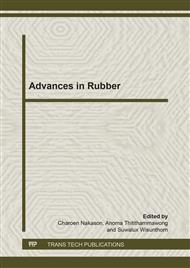p.247
p.251
p.255
p.259
p.263
p.267
p.272
p.276
p.280
Effect of Bis (Triethoxysilylpropyl) Tetrasulfide on Physical Properties of Rice Husk Fiber/Natural Rubber Composites
Abstract:
In this study, rice husk fiber (RHF), a byproduct from rice milling process, was used as reinforcing filler for natural rubber (NR). Generally, RHF surface and NR have different polarity. Therefore, fiber surface treatment was employed in this work to improve compatibility between RHF and NR. RHF was pretreated with alkali solution for 2 h (2ALT) before treating with various bis (triethoxysilylpropyl) tetrasulfide (Si69) contents, i.e., 2, 5 and 10 wt%. Physical properties of RHF and RHF/NR composites were characterized. FTIR spectra of Si69 treated RHF (ST) confirmed the appearance of Si69 on RHF surface. With increasing Si69 content, the peak position of FTIR absorption bands of ST did not changed. For NR composites, scorch time of ST/NR composites was longer than that of 2ALT/NR composites. With increasing Si69 content, there was no changed in scorch time of NR composites. ST/NR composites showed the maximum values of M100, M300, tensile strength and tear strength at Si69 content of 5 wt% indicating the improvement of rubber-fiber interaction and fiber dispersion in NR matrix.
Info:
Periodical:
Pages:
263-266
Citation:
Online since:
November 2013
Authors:
Keywords:
Price:
Сopyright:
© 2014 Trans Tech Publications Ltd. All Rights Reserved
Share:
Citation:


